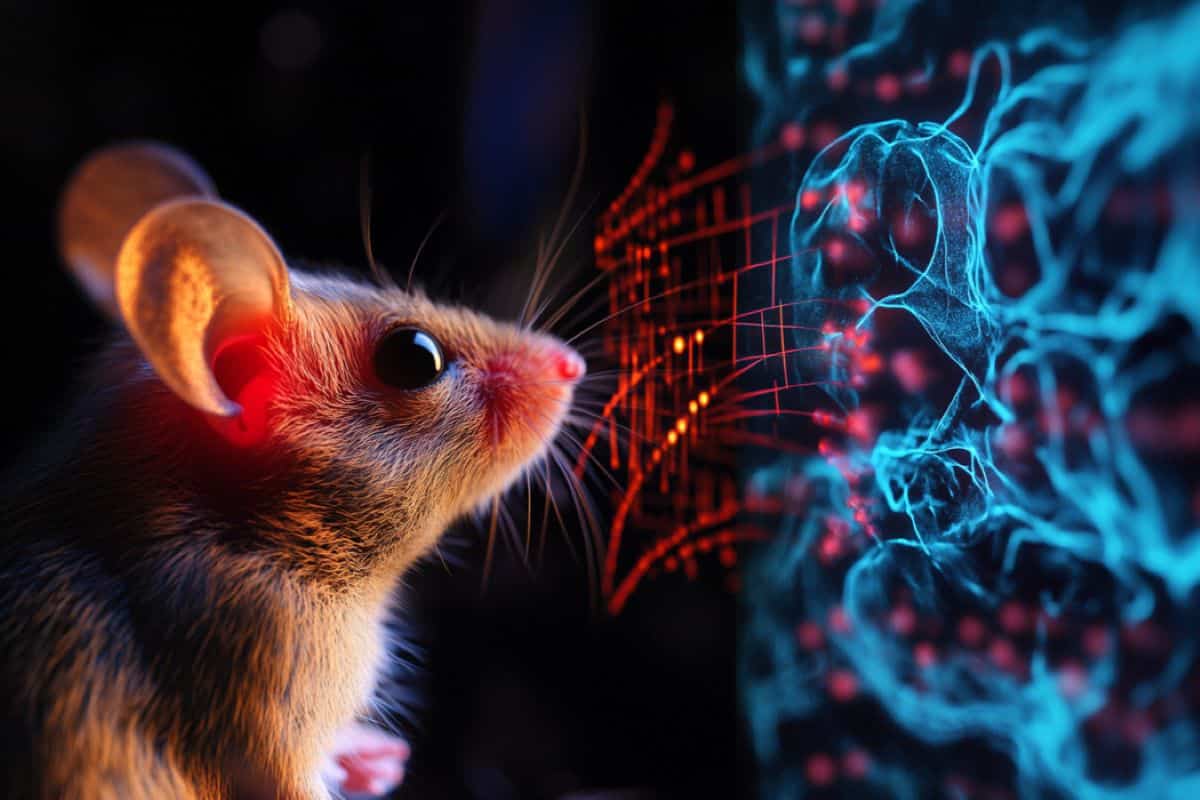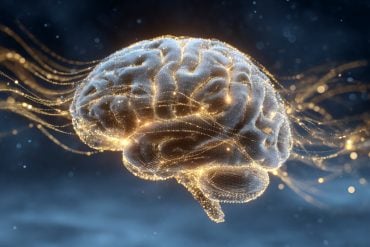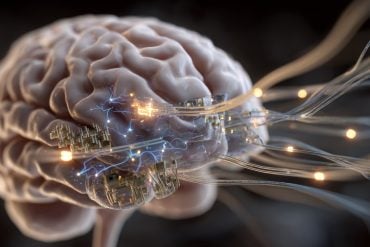Summary: New research demonstrates that stimulating the vagus nerve enhances perceptual learning, allowing animals to better distinguish subtle sensory differences over time.
In the study, mice trained to differentiate tones improved more when their vagus nerve was stimulated, surpassing performance plateaus seen in unstimulated mice. This stimulation activated regions in the brain associated with attention, memory, and neuroplasticity, suggesting it might enhance adaptability to new experiences. The findings imply that vagus nerve stimulation could help humans improve sensory-based skills, including adjusting to cochlear implants.
Researchers plan to investigate this approach further in humans, particularly to assist those with hearing impairments. This study highlights the potential of non-invasive techniques to boost learning and sensory adaptation.
Key Facts
- Vagus nerve stimulation enhanced learning in mice, allowing them to perceive subtle differences better.
- Stimulated mice displayed increased neuroplasticity in the auditory cortex.
- Findings could improve learning and sensory adaptation in humans, particularly for those with cochlear implants.
Source: NYU Langone
Just as a musician can train to more sharply distinguish subtle differences in pitch, mammals can improve their ability to interpret hearing, vision, and other senses with practice. This process, which is called perceptual learning, may be enhanced by activating a major nerve that connects the brain to nearly every organ in the body, a new study in mice shows.
Led by researchers at NYU Langone Health, the investigation centers on the vagus nerve, which carries signals between the brain and the heart, digestive system, and other organs.
Experts have long explored targeting this nerve with mild electrical pulses to treat a wide variety of conditions ranging from epilepsy and depression to posttraumatic stress disorder and hearing disorders.

Results of such efforts have been mixed, however, and the underlying mechanisms that might lead to improved hearing had until now remained unclear.
To more closely examine whether vagus nerve stimulation can boost perceptual learning, the study team trained 38 mice to tell apart musical tones. At first, performance improved for all animals, which made fewer and fewer mistakes over time.
However, while those without the treatment maxed out after about a week of training, rodents that received nerve stimulation continued to get better at the task, making roughly 10% fewer errors on average for most tests than they did prior to simulation.
In addition, mice in this group made half as many mistakes as their counterparts on the most challenging assessments, in which they needed to distinguish very similar tones.
“Our findings suggest that activating the vagus nerve during training can push past the limits of what animals, and perhaps even humans, can learn to perceive,” said study lead author Kathleen Martin, BS, a graduate student at the Neuroscience Institute at NYU Grossman School of Medicine.
In a second part of the investigation, the researchers assessed how and where vagus nerve stimulation affects the brain. The results revealed that the technique boosts activity in the cholinergic basal forebrain, a region involved in attention and memory. When the team instead suppressed this area during nerve activation, rodents did not gain additional learning benefits.
In addition, the team showed that vagus nerve stimulation increased neuroplasticity, a process in which brain cells become more able to adapt to new experiences and form memories, in the auditory cortex, the brain’s main center of hearing. This can lead to long-term cellular changes that allow new skills to endure well after training occurred, says Martin.
She notes that targeting the vagus nerve to boost hearing has previously been controversial among experts, with past studies in animals failing to show significant improvements.
The new study, which published online Sept. 16 in the journal Nature Neuroscience, suggests that the method can indeed work, although results took longer to show up than researchers initially expected, the authors say. This delay, Martin adds, might in part arise because the electrical pulses used in the technique can distract test animals, which may need time to adjust to the sensation.
The authors note that using vagus nerve stimulation to enhance hearing has potential applications far beyond maximizing musical ability. Perceptual learning is a key component of both understanding a new language and adjusting to cochlear implants, neuroprosthetic tools used to restore hearing loss. Notably, patients often take months to adjust to these devices and many continue to struggle with conversations even after years of use.
“These results highlight the potential of vagus nerve stimulation to speed up hearing improvements from cochlear implants,” said study senior author Robert Froemke, PhD. “By boosting perceptual learning, this method might make it easier for implant recipients to communicate with others, hear cars approaching, and engage more effectively with the world around them.”
Froemke, the Skirball Professor of Genetics in the Department of Neuroscience and Physiology at NYU Grossman School of Medicine, says that the electrical stimulator devices currently used to activate the vagus nerve are only a few centimeters across and can be implanted in an out-patient surgical procedure. Some devices, such as those used to ease migraines, are even less invasive and are simply held against the skin of the neck.
Based on their findings, the researchers next plan to test vagus nerve stimulation in rodents with cochlear implants to see if it improves their function, says Froemke, also a professor in the Department of Otolaryngology – Head and Neck Surgery at NYU Grossman School of Medicine.
Also a member of NYU Langone’s Neuroscience Institute, Froemke cautions that since the vagus nerve is much larger and more complex in humans than in mice, the effects of stimulating it may differ and therefore warrant further testing in human patients.
Funding: Funding for the study was provided by National Institutes of Health grant DC012557. Further study funding was provided by the United States Department of Defense and the National Science Foundation.
In addition to Martin and Froemke, other NYU Langone researchers involved in the study are Eleni Papadoyannis, MA; Jennifer Schiavo, PhD; Saba Shokat Fadaei, MS; Habon Issa, BS; Soomin Song, PhD; and Sofia Orrey Valencia, BS. Other study co-investigators include Nesibe Temiz, PhD, at the Friedrich Miescher Institute for Biomedical Research in Basel, Switzerland; Matthew McGinley, PhD, at Baylor College of Medicine in Houston, Tex.; and David McCormick, PhD, at the University of Oregon in Eugene.
About this brain stimulation and learning research news
Author: Shira Polan
Source: NYU Langone
Contact: Shira Polan – NYU Langone
Image: The image is credited to Neuroscience News
Original Research: Closed access.
“Vagus nerve stimulation recruits the central cholinergic system to enhance perceptual learning” by Kathleen Martin et al. Nature Neuroscience
Abstract
Vagus nerve stimulation recruits the central cholinergic system to enhance perceptual learning
Perception can be refined by experience, up to certain limits. It is unclear whether perceptual limits are absolute or could be partially overcome via enhanced neuromodulation and/or plasticity.
Recent studies suggest that peripheral nerve stimulation, specifically vagus nerve stimulation (VNS), can alter neural activity and augment experience-dependent plasticity, although little is known about central mechanisms recruited by VNS.
Here we developed an auditory discrimination task for mice implanted with a VNS electrode. VNS applied during behavior gradually improved discrimination abilities beyond the level achieved by training alone.
Two-photon imaging revealed VNS induced changes to auditory cortical responses and activated cortically projecting cholinergic axons. Anatomical and optogenetic experiments indicated that VNS can enhance task performance through activation of the central cholinergic system.
These results highlight the importance of cholinergic modulation for the efficacy of VNS and may contribute to further refinement of VNS methodology for clinical conditions.






